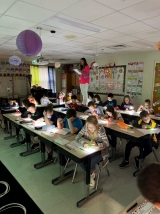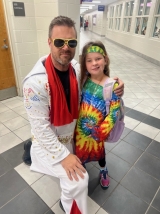-
Category 3
Selected in 2023
-
Grades: pre k - 5
School Setting: urban
Town Population: 7,836
Student Enrollment: 625
Student Demographics:
Black/African American: 4%
Teacher/Student Ratio: 1:20
White/Caucasian: 93%
Hispanic: 3%
Hawaiian/Pacific Islander: 0%
Asian: 0%
Native American: 0%
Other: 0%
% Reduced Lunch: 88%
% ELL Learners: 3%
Founded: 1994 -
PRINCIPAL:
Brian Bond -
CONTACT:
8325 S US 25
Corbin, KY 40701
606-862-4655
brian.bond@laurel.kyschools.us
Hunter Hills Elementary School
Corbin, KY
Start with the kids.
- 1. Tell us about your school’s success.
- Simply put, Hunter Hills is one of the most successful large (600+), high poverty (85+ free/reduced lunch) schools in the nation. For the last 12 years The Hills has scored the highest designation on Kentucky's state assessment. This includes being a: Distinguished School (90th percentile), a School of Distinction (95th percentile), 5-Star School and now a Blue School (2 years running). We've also been named a Model School by the Kentucky Department of Education and a High Flying School by the National Youth At Risk council. Hunter Hills has also finished in the top 10 among all Kentucky schools and holds the imaginary heavyweight title of large elementary Schools in its demographic.
- 2. Talk about the greatest contributing factor(s) that promoted positive change in your school.
-
Start with the kids. Every decision should be based on what will be best for your students. Warning! This rarely means what's easiest and requires constant reinforcement and encouragement. We've found that staff at high poverty schools must take it student success personally. While this is tough, it is well worth it! Many people live their whole life without knowing whether they really made a difference. At the Hills staff get that question answered daily.
We also believe leadership also plays a huge role in promoting a positive culture. To see more of the details on the impact of our leadership see question 5.
Losing breeds negativity so celebrate every success, no matter how small at first. Often with high poverty schools, the focus should initially be on growth, not the overall score. Celebrate growth and eventually you'll be celebrating overall success!
Change in high poverty schools requires extra creativity, resilience and energy, but we are proof that it can be done!
- 3. How has ESEA funding supported the school's success?
-
When you are a high poverty school, ESEA effects every aspect of your school. ESEA has allowed us to add quality staff. These teachers, assistants and tutors allow our school to lower class size, offer a broader range of enrichment content and direct instruction in small group format. For example, one the average school day, we have over 50 reading small groups- many of these are led by ESEA funded staff.
ESEA also help give our students opportunities for new experiences through field trips and guess speakers. These funds also provide for after-school tutoring in grades kindergarten thru fifth grades, daytime small group tutors and our highly successful summer school program. These funds also support our reading program by keeping the library open after-school for two days each week, while providing supplementary books and materials for the classroom.
ESEA funds are used to improve educator performance by providing opportunities to attend a myriad of trainings and conferences.
- 4. What professional development activities were used to improve teaching and learning?
-
Hunter Hills professional development will take a two pronged approach each year. First, we will target specific areas for that particular year. Examples include: a new reading series will mandate PD over how to use the materials or data may dictate a specific content strand needs strengthened. Secondly, our PD plan always includes trainings on how to teach and lead students in low income families. Topics such as trauma, resiliency, overcoming environmental barriers are explored and included every year. Each year we do a staff book study that lasts throughout the whole year. Many of these are books written by students who provide a first hand view of a student dealing with poverty. These book studies or PD activities will not just be discussed on PD days, but in weekly staff meetings or PLC's.
Much of our professional development includes a motivational aspect to combat the burn-out and fatigue that inherently go with teaching a large, high poverty school. - 5. Talk about the cultural shift leading up to your school's success.
-
Mr. Bond was the 7th principal in 11 years at Hunter Hills. The year before his hiring, two teachers physically fought on the playground, discipline was near out of control and test scores were at the bottom. To say a cultural shift was needed would be an understatement.
Mr. Bond was also able to hire his own leadership team of a new assistant principal, counselor, curriculum coach and secretary.14 years later these positions are still integral to the success of Hunter Hills. When staff see administration doing extra for students it sets the expectations for them to adopt.
Most staff go into education because they want to change children's lives and be part of something bigger than themselves. Where better to do this, than working with students from low-income families? Cast a vision and set a purpose that will motivate staff into becoming something more, then provide every support imaginable to help them get there. Revisit this purpose weekly, if not daily with words AND actions. - 6. How has community involvement strengthened your success?
-
Community involvement is integral to the success of a school and is often a special challenge with low-income areas. Hunter Hills is no different. Our greatest resource has been local churches. Local churches have provided support and resources, sponsored families in need during the holidays and "adopted" staff.
Local businesses also play a key role of support. When The Hills sent students for the first time to an overnight trip to Washington DC community partners were instrumental in coordinating a neighborhood 5K to help fund the trip.
Our incredible Family Resource Center works with community partners to remove non academic barriers to students' success. They partners with families to sponsor such events as: monthly family reading nights, Grinchmas, father/mother/grandparents breakfasts, arts and crafts nights, etc. Community partners help supply clothing and food to our families when needed. The FRC even works with a non-profit to give free dental care to students who qualify.
Stats
-
Category 3
Selected in 2023
-
Grades: pre k - 5
School Setting: urban
Town Population: 7,836
Student Enrollment: 625
Student Demographics:
Black/African American: 4%
Teacher/Student Ratio: 1:20
White/Caucasian: 93%
Hispanic: 3%
Hawaiian/Pacific Islander: 0%
Asian: 0%
Native American: 0%
Other: 0%
% Reduced Lunch: 88%
% ELL Learners: 3%
Founded: 1994 -
PRINCIPAL:
Brian Bond -
CONTACT:
8325 S US 25
Corbin, KY 40701
606-862-4655
brian.bond@laurel.kyschools.us







